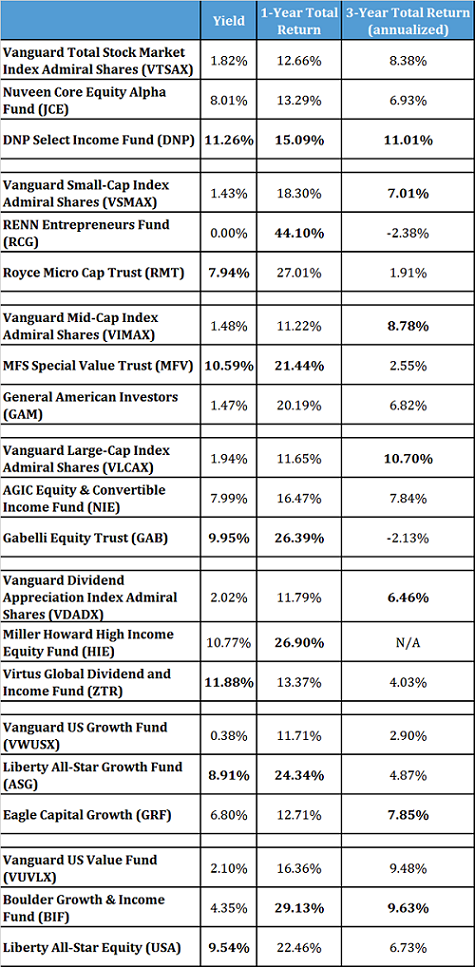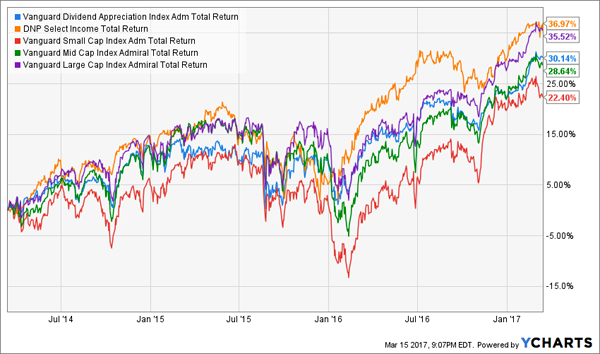14 Funds That Crush Vanguard And Yield Up To 11.9%
 Vanguard is killing it. They’re now the biggest money manager in the world, with a whopping $4 trillion in assets under management.
Vanguard is killing it. They’re now the biggest money manager in the world, with a whopping $4 trillion in assets under management.
It’s a feel-good story for a lot of investors, since the low-fee index fund juggernaut has marketed itself as the humble alternative to the high-rolling Wall Streeters who have become the target of public ire since the global financial crisis.
The feel-good story is simple. Vanguard has low overhead, pays its executives relatively modestly and passes those savings on to investors. Because of lower fees, the investors win; because of economies of scale, Vanguard wins; and because of the efficient-market hypothesis, which says hot-shot analysts can’t consistently outperform the stock market in the long run, the only people who don’t win are those evil banksters.
Of course, this feel-good story is a myth.
The reality is that Vanguard’s funds do not outperform many more complex alternatives over several time periods. And when you look at closed-end funds, you’ll find several that outperform Vanguard’s big index-tracking funds despite having higher fees, being actively managed by Wall Street professionals and having dividend payouts that are five or six times greater than Vanguard’s.
To demonstrate this point, let’s look at some CEF alternatives to mutual funds.
To do this, I’ve chosen CEFs that are as close to the Vanguard funds as I could. However, because CEFs tend to take advantage of unconventional and less understood asset classes, none of these are 100% comparable to the Vanguard mutual funds.
However, their performance should roughly track the Vanguard funds, both over the short and long term, because they’re roughly focused on comparable areas of the stock market.
Below you’ll find some CEF alternatives to Vanguard’s popular low-cost market-tracking funds, such as the Vanguard Total Stock Market Index Admiral Shares (VTSAX), Vanguard Small-Cap Index Admiral Shares (VSMAX), Vanguard Mid-Cap Index Admiral Shares (VIMAX), Vanguard Large-Cap Index Admiral Shares (VLCAX), Vanguard Dividend Appreciation Index Admiral Shares (VDADX), Vanguard US Growth Fund (VWUSX) and Vanguard US Value Fund (VUVLX).
Below each, I’ve listed two CEF alternatives (though there are many more). I’ve also highlighted the winning fund’s one-year and three-year performances in bold. Since there is great value in getting a high rate of immediate income, I’ve also bolded the highest dividend yield.

Vanguard’s funds never win.
Not only do they never win, but they’re almost never in the top spot for any of these three metrics. We do see VSMAX, VIMAX, VDADX and VLCAX beating out the CEF alternatives over a three-year time period—but one can ignore this entirely and just buy the DNP Select Income Fund (DNP), whose 11.01% total return over the last three years beats VSMAX, VIMAX, VDADX and VLCAX:
The Winner? Not Vanguard!

And this is just one of many other CEFs that beat these funds over a three-year time horizon.
When it comes to yields and one-year returns, none of the Vanguard funds win. Despite their popularity, despite the passive-indexing craze and despite the feel-good story many want to believe is true—Vanguard is a laggard.
In the case of VWUSX, you’re talking about the difference between a good 11% gain and a massive 24% gain over one year with the Liberty All-Star Growth Fund (ASG).
And again, there are many other CEFs that have beaten VWUSX over the last year.
What about longer timeframes?
Here’s the rub: many CEFs are too new for us to make the comparison. Mutual funds are literally hundreds of years old (the idea comes from Dutch merchants in the 17th century), so there’s a long track record to look at.
Exchange-traded funds are newer but have exploded in popularity thanks to aggressive marketing and the ease with which they are understood. CEFs are a much newer financial innovation and remain largely misunderstood and under-appreciated by investors.
Of course, we haven’t even dug into the income issue; these funds are paying yields of 8% or higher, versus the paltry 2% or lower income stream from Vanguard’s funds. That means you can plug $1,000,000 into these funds and get an $80,000 income stream—or even more. Conventional wisdom tells you that you have to sacrifice long-term performance for short-term yields.
The conventional wisdom is wrong. And this, of course, is a great opportunity.
A Better Way to Bury Vanguard and Collect 10%+ Dividends
The 14 CEFs I just showed you are great if you just want to beat Vanguard’s offerings, but we can do way better than that. We can easily leave the first-level investors who buy the fund giant’s products firmly in our dust.
We’ll start with 3 other CEFs that pay gaudy 8.2% to 10.1% yields now—more than quadrupling our Vanguard funds’ wimpy 2%. Plus, thanks to the Fed (and irrational headline-driven selling), these income wonders are trading at one-time discounts of 10 to 15% of their true value.
That’s our cue to strike.
Because even if the market takes a tumble, these funds’ massive discounts mean they’ll simply trade flat, and we’ll happily pocket their 8.2% to 10.1% payouts.
And when the herd comes around to the fact that it will still be years—if ever—before Treasuries match CEFs paying 8% and up, these 3 funds will soar by double digits—and that abnormal discount will vanish overnight!
That’s why we’ve made these 3 unsung funds the heart of our “8.0% No-Withdrawal portfolio.”
It’s a unique collection of investments that draws from many corners of the high-yield universe—CEFs, real estate investment trusts (REITs) and preferred shares among them—to let you quietly collect a $40,000 income stream on every $500,000 you invest.
I’m ready to share the names of all 6 of these “steady Eddies” with you—including our 3 favorite CEFs for double-digit yields and price upside—now. Click here to get our full retirement plan and the names of the 6 cash machines that make it work.
Category: Closed-End Funds (CEFs)




